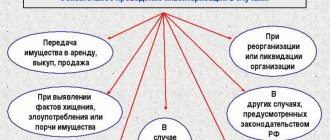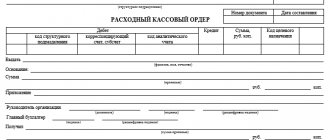Every officially employed employee has the right to accrue sick leave benefits (temporary disability benefits) in the event of injury or illness. The procedure for paying sick leave assumes that the head of the enterprise will pay only the first 3 days of illness, and the remaining days will be paid from the budget of the Social Insurance Fund. Accounting entries for sick leave will depend on what source the funds come from, what activities the company is engaged in, whether the region where the company is located is participating in the Social Insurance Fund pilot project or not. We will consider possible wiring options in the article.
Accounting entries for sick leave when calculating benefits at the expense of the employer
The fiscal operation for calculating the amount of temporary disability benefits is carried out in the same way as in the case of payroll. The debit of the account will depend on which expense account the salary of the employee who issued sick leave is always credited to (in this case, the CREDIT account will always remain 70 “Settlements with personnel for wages”):
| DEBIT account | A comment |
| 20 | If the employee is involved in the main production |
| 23 | When an employee performs labor functions in auxiliary production |
| 25 | When assigning costs to general production expenses |
| 26 | When assigning expenses to general business expenses |
| 29 | Service industries and farms |
| 44 | When assigning payment expenses to selling expenses |
| 91 | Other income and expenses |
Features of transactions under an insurance contract
Accounting entries in the insurance industry are records in a single computer database. They are needed to display changes in the state of accounting objects - policyholder premiums. Data on the policy can be taken into account and recorded starting from the day when it is considered valid. The legislative framework does not have a uniform accounting procedure for expenses on insurance services; they can be attributed to expenses once or adjusted throughout the entire period of insurance. At the same time, only the actual paid part of the premium is included in expenses. When the amount is paid in part, the premium is calculated not for the entire period, but for the period already paid.
Important! The amount of the insurance premium is present in the insurance policy and is calculated according to tariff rates adopted by the insurer or supervisory authorities. If the contract is terminated early or an insured event occurs, the amount of compensation is displayed in the accounting database.
Postings in accounting and tax accounting are divided into two parts: debit and credit. In the second, subaccount 76-1 is indicated when the policyholder is a legal entity. The debit account includes accounts for basic expenses and other expenses, if it concerns a one-time write-off.
Article on the topic: Peculiarities of terminating a compulsory motor liability insurance policy and returning money for insurance at IC Alfa Insurance
With each type of write-off, discrepancies arise between accounting and tax information:
- In accounting, write-offs occur immediately and throughout the full insurance period. In NU, the premium will be written off once only for insurance that is valid within a single reporting period for income tax.
- Costs in BU are taken into account in full; NU contains tariff frameworks for all insurance products.
- In BU, the display of expenses begins from the day when the policy begins to operate according to the law; in NU, it is recorded from the moment the policyholder makes payment.
To insure a car and other vehicles, they use a unified account system with the number 76-1.
Property insurance accounting
Property insurance can be voluntary or mandatory; this insurance product is on the list of the most common. Transactions under a property insurance contract are recorded on a standard account with number 76-1. If the premium amount has already been paid, it is fixed in this way - D76-1 K51. Property insurance costs are calculated from the date the policy comes into force. When it is not provided, the insurance is recognized as valid after payment of the premium. After taking into account all costs, postings of type D20 (26) K97 (76-1) are entered into the database.
Accounting for expenses for OSAGO and CASCO policies
Motor vehicle insurance costs are considered as expenses for standard types of activities. Accounting for CASCO or OSAGO in BU and OSNO is carried out using account number 76-1, as for policies for property type of insurance. For MTPL policies for a car with a period of more than 1 month, wiring numbered D20 (26) K76-1 is used, less than a month - D20 (26) K76-1. In the event of termination of a CASCO or MTPL policy before expiration, the insurer is obliged to return part of the amount to the policyholder, and the accounting entry will look like this: D51 K76-1. After the auto insurance policy is written off, it is recorded in the database using the K13 posting.
Article on the topic: Termination of an insurance contract and return of money to IC "Rosgosstrakh"
Reflection in accounting of insurance for employees
Employees of different companies most often receive medical insurance from their employer. This insurance is regarded as a voluntary type; the costs of such contracts can be recorded on account number 76-1. At the time of payment of the premium amount, a posting numbered D76-1 K51 is added. For contracts with a term of more than a month and expense data included in the list of costs, posting of the type D20 (26) K76-1 is used. If we are talking about a policy with a term of no more than a month, then the payment amount is taken into account in the list of costs by another entry D20 (26) K76-1.
Accounting entries for sick leave when calculating benefits at the expense of the Social Insurance Fund
The accountant should take into account the fact that the reflection in the accounting records of the operation for calculating temporary disability benefits will depend on the reason for being on sick leave (general illness, domestic injury, pregnancy and childbirth, work injury).
Important!
To reflect the accrual of sick leave benefits from the Social Insurance Fund for sick leave in the event of an industrial injury, maternity and disability, separate sub-accounts must be opened to account 69.
| DEBIT | CREDIT | Operation, comment |
| 69 | 70 |
|
| Debit of the subaccount (for calculating social insurance against industrial accidents) to account 69 | 70 | When accruing sick leave benefits in the event of an employee being injured at work (all days are paid from the Social Insurance Fund). |
Registration and calculation of sick leave
Sick leave sheets are located in the “Salaries and Personnel” - “All Accruals” section.
In the list of documents that opens, click on the “Create” button. You will see a menu with a choice of document type. In our case, this is “Sick Leave”.
In the form of the newly created document that opens, indicate the month, organization and the employee whose sick leave you want to reflect in the program.
Basic data
The “Main” tab indicates the number of the sick leave and whether it is a continuation of another. The cause of disability is selected from the default list. This could be illness or injury, quarantine, parental leave, etc.
Below, indicate for what period the employee is exempt from work in accordance with the sick leave. The default payment percentage is set at 60%, but depending on the employee’s length of service, you can of course change it.
At the very bottom of the form, on the “Main” tab, accruals and personal income tax are automatically calculated. The accrual is automatically divided into that paid by the employer and the Social Insurance Fund. You can only adjust personal income tax and average earnings data by clicking on the pencil sign.
We will not consider personal income tax adjustments in detail, since everything is already intuitive there. Let's focus on average earnings. Click on the pencil sign.
You will see Form 1C 8.3 with a detailed monthly calculation of the average earnings of employees.
Here you can adjust the data that affects your average earnings. This is done in the case when an employee recently came to work at your company, and there is no data on his earnings from his previous place of work. Or the program did not previously accrue payroll.
There are also very frequent cases where it is necessary to change the billing period. For example, an employee has returned from maternity leave; therefore, she may not have accruals for the time worked, as well as the time worked itself. In this case, when calculating sick leave, she can change the years for calculating average earnings to those when she actually worked (before maternity leave).
Additional data
Go to the “Advanced” tab. In our case, all data was filled in automatically.
In the benefit limitation field, the value “Limit value of the base for calculating insurance premiums” is automatically inserted. You can change this limit to the minimum wage, or to the minimum monthly insurance payment.
Part-time rates and benefits are listed below. The list of available benefits is shown in the figure below.
Accruals
In our case, on the “Accruals” tab, two lines appeared: “Sick leave at the expense of the employer” and “Sick leave”. The fact is that in our case, the employee is entitled to payment of benefits for 8 days. The first three days are paid by the employer, and the subsequent days by the Social Insurance Fund. If the period were no more than three days, then this tab would only have a line with the amount of sick leave at the expense of the employer.
In the tabular part of the accruals, you can only change the benefit amounts. On the “Main” tab, all changes you make will be reflected and the amounts will be recalculated automatically.
Postings on sick leave
Post the document and open its transactions. As we see, the amount of benefits, which is paid at our expense, is related to wages (Dt26). The part of the benefit that is paid at the expense of the Social Insurance Fund is taken into account on Dt 69.01.
See also video instructions:
Legislative regulation
| Art. 183 Labor Code of the Russian Federation | On the right of employees to receive sick leave benefits |
| clause 1 part 2 art. 3 of the Federal Law of December 29, 2006 No. 255-FZ | About sources of payment for sick leave |
| Clause 2 Decree of the Government of the Russian Federation dated April 21, 2011 No. 294 | On the dependence of accounting for the payment of sick leave benefits on the participation of the region where the company is located in the Social Insurance Fund pilot project |
| clause 3 of the Amendments, approved. Decree of the Government of the Russian Federation dated December 19, 2015 No. 1389 | On inclusion in the FSS pilot project. Republic of Mordovia, Bryansk, Kaliningrad, Kaluga, Lipetsk and Ulyanovsk regions |
| Art. 9 Federal Law of July 24, 1998 No. 125-FZ | On compulsory social insurance against accidents and occupational diseases |
| clause 1 art. 217 Tax Code of the Russian Federation | The fact that maternity benefits are not subject to personal income tax |
Common mistakes
Error:
An accountant of a company from the region that is participating in the FSS pilot project displays in the accounting records the accrual of benefits at the expense of the FSS.
A comment:
Employers of firms from regions participating in the FSS pilot project should not display benefits at the expense of the FSS in their accounting records, since the FSS directly transfers the benefit to the employee’s account, without transferring funds to the employer.
Error:
The accountant reflected in the accounting records the payment of sick leave benefits for an industrial injury at the expense of the employer (for the first 3 days).
A comment:
When an employee receives a work-related injury, sick leave benefits for the entire period of sick leave are paid from the Social Insurance Fund.
How are the costs of sick leave taken into account?
Postings on sick leave at the expense of the employer are possible only for the first 3 days; on the 4th day, payment is taken over by the Social Insurance Fund. The company is obliged to pay employees and days of absence from work during their illness.
The costs and income of organizations are recorded in books and journals on the turnover of funds, and benefits are posted to accounts that serve as a source of their reimbursement. In order for an employed citizen to exercise his right to payment for days during illness, he must undergo outpatient or inpatient treatment at a medical institution, where a certificate of incapacity for work will be issued; the recovered employee will submit it to the personnel department at his place of work.
The HR officer will note the length of service, further calculations depend on this, and the document goes to the accounting department. The time missed for treatment is indicated in the sick leave column. The accountant will have to sample salaries for the last 2 years to calculate average earnings.
The law sets a deadline for the payment of benefits; it cannot be violated, so financiers create transactions and post expenses in a timely manner.
Federal Law No. 255 regulated the procedure for calculating sick leave; they must be paid within 10 days after being provided to the employer. The full calculation and payment, regardless of the duration of the illness, is carried out by the employer, but from his own funds he will spend only 3 working days on payment, for the rest of the period he will be returned social insurance after submitting a report on the payments made.
The accountant calculates the reflection of the money transferred for disability after deduction of personal income tax, calculations are performed in the same way with accrual and deduction for wages. In this case, debit 70 of the account corresponds to credit 68. BIR benefits are not subject to taxation.
The binary notation depends on the source of transfers for the certificate of incapacity; the first digits indicate income, the second digits indicate expenditure, which means D-t and K-t:
- cash payment – 70/50
- payment of sick leave from a current account – 70/51
- reimbursement of funds to the employer from the Social Insurance Fund - 51/69
To organizations, compensation for sick leave is transferred from social insurance funds to their current accounts.
If maternity benefits have been accrued, the posting reflects the full reimbursement of funds from the Social Insurance Fund budget:
- accrual – 69/70
- payment – 70/50 or from the current account K-t 51
You should know that enterprises participating in the special program of the Social Insurance Fund for direct payments mark maternity leavers due to their absence only in work sheets. There are no financial entries, since employers do not make payments, but they keep the documents.
Woman on maternity leave
The Social Insurance Fund has introduced a new project, with the approval and support of the Government, related to reforms of insurance fees, which is at the stage of a kind of testing. It was named pilot because payments are made directly to the account of an employed person in the event of illness and sick leave.
The regions for testing are selective; they were appointed by government officials. After official registration for work, the employee’s data is sent to the Social Insurance Fund; this procedure ensures uninterrupted payments. The entire territory of the Russian Federation is not participating in the project, since first it is necessary to study all the nuances of the innovation in order to immediately eliminate the possibility of risks.
The new provision concerns:
- official workers
- managers of enterprises or their services responsible for calculations
- medical institutions
Money for an ill employee will be sent directly to his card or by postal order in the following cases:
- illnesses, work injuries
- BIR benefits
- birth of children
The responsibilities of the management of enterprises that have joined this program in relation to mandatory insurance contributions have changed; they must make mandatory transfers for the staff. It is believed that with the help of the newly developed scheme for citizens, payments will be made on time.
| Debit | Credit |







